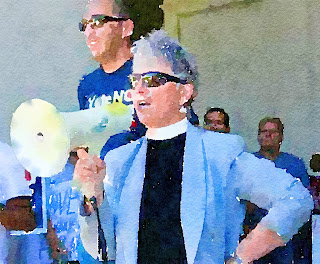The most recent example in my little corner of the continuum was Sunday's unfortunate NYT op-ed with the click-bait title Why Churches Should Drop Their Online Services.
I'll admit I only read it because I was scrolling down the page to get to the Spelling Bee ... but once I did I immediately started to write my response in my head. I have been at this long enough to pause and at least ask myself the "moth to the flame" question. In this case, myself answered "go for it" -- and so I did: sharing my critique of both the context and conclusion of the piece on social media and with some lively discussion resulting.
The op-ed was written by Tish Harrison Warren -- a priest in the Anglican Church in North America: an author and frequent contributor to the NYT Opinion page. The piece in question is linked above ... but it is behind the NYT paywall. So in case you're not a subscriber, here's a quote that gives you the gist of the author's premise:
“One might ask, why not have both? Why not meet in person (with Covid precautions in place) but also continue to offer the option of a live-streamed service? Because offering church online implicitly makes embodiment elective. It presents in-person gatherings as something we can opt in or out of with little consequence. It assumes that embodiment is more of a consumer preference, like whether or not you buy hardwood floors, than a necessity, like whether or not you have shelter …
No longer offering a streaming option will unfortunately mean that those who are homebound or sick will not be able to participate in a service. This, however, is not a new problem for the church. For centuries, churches have handled this inevitability by visiting these people at home in person.”
And here was my response:
It figures that the ACNA priest who writes for the NYT would come down on the either/or side of the in-person/on-line worship debate. Sorry, but we live in a both/and world — and if ANY tradition is ontologically wired to meet that challenge it is the actual Anglican/Episcopal one. Forged out of the crucible of the Reformation, we are a church that has historically chosen to be both catholic and protestant. Surely we can be a church that builds community both virtually and physically and not exclude our shut-ins and immuno-compromised siblings from the opportunity to share virtually in our gathered community.
At my parish we’ve been streaming our services for over a decade and going to “in person only” would be an unnecessary diminishment of the value of radical inclusion that we hold as a Gospel imperative. And — for the record — we also welcome, affirm and celebrate LGBTQ+ people as full members of the sacramental life of the Body of Christ. But that’s another op-ed.
Could I have just kept scrolling on down the the Spelling Bee and left well enough alone? Sure. But I would also have missed out on the chance to engage in some lively and enlightening conversation about what makes liturgy the work of the people; what it means to live sacramental lives in a time of virtual community; how we meet the both/and needs of our communities of faith in these complex times without resorting to simplistic either/or answers.
Arguably my favorite exchange was this one on Twitter with friend and colleague Scott Gunn:
And I'll take that as Game, Set and Match for Public Theology: at least this time!


No comments:
Post a Comment